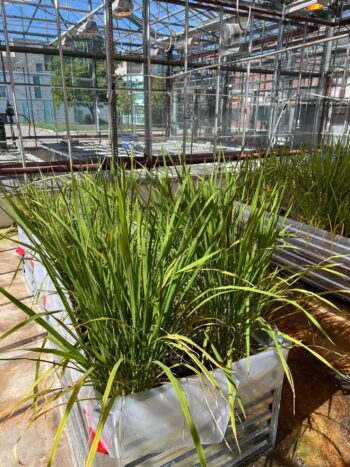Rice is a staple crop for more than half the world’s population. It’s also highly sensitive to soil salinity, a growing problem driven by multiple factors from overuse of fertilizers to sea water intrusion into coastal aquifers, prompting a race to breed more salt tolerant crops.
One such crop, billed by Canadian startup ALORA as “the most salt-tolerant terrestrial plant on the planet,” is now on trial at the University of Guelph in Ontario, and has the potential to change the game, claims the firm.
The Guelph trial features gene edited rice plants grown in water containing 8 grams of salt per liter (for context, sea water is 28-32g/L), although ALORA cofounder Luke Young is confident he can “push that salinity tolerance all the way up to 28g by the end of this year.”
To place this in context, many competitors have not passed the 1g/L mark for rice, claims Young, although recent reporting from China references varieties that can grow in salinity levels of up to 4g/L.

According to Young: “What this trial in Canada is designed to show is that we can achieve normal yields, the same as can be achieved without salt present, at 8g salt per liter.
“The trial is set to complete around mid-October but we’re tracking everything [chloroplast operation, metabolism, chloroplast ultrastructure, leaf anatomy etc], so before we get to harvest, we already have a good sense of how well the plants are performing, and so far we are on track for this being the best performing salt-tolerant rice plant in the world.”
Assuming the Guelph trial is a success, he says, three potential commercial partners are ready to sign on the dotted line, enabling ALORA to start generating revenues.
‘We are turning non-productive land into productive land’
So how does it work?
Young and cofounder Rory Hornby—who met while studying biology at Durham University in the UK—have developed patent-pending gene editing technology that activates a set of genes that are found in multiple plants but are only active in coastal plants such as seagrasses, conferring levels of salt tolerance they claim are unparalleled for terrestrial crops such as rice.
In terrestrial plants, “the mechanism [conferring salt tolerance] is not turned on as it doesn’t need to be,” explains Young.
While ALORA’s initial focus is on rice, the technology can also be applied to several other crops including corn and cotton.
Salt-tolerant rice is not new, observes Young, referencing the work of Chinese agricultural scientist Yuan Longping using traditional breeding techniques, startups such as Red Sea Farms, and ag giants such as Bayer.
ALORA, however, has achieved significantly higher tolerance levels through its application of CRISPR technology, claims Young, who has raised $3.72 million in seed funding from investors including Toyota Ventures, the Sustainable Oceans Alliance, and Mistletoe, and aims to raise a series A round late next year.

Ocean agriculture
Interest in ALORA’s technology has come from all over the world, he says. “Long term we’re looking at ocean agriculture, but the plan was always land agriculture first. There are areas across Vietnam, the Philippines, Japan and the US that are having huge issues with saltier soil. But increasingly it’s becoming a problem in a lot of countries you wouldn’t really expect; Argentina’s aquifers, for example, are getting more and more saline, and there’s no real solution.”
ALORA—which was founded in 2019—currently has a trial in Singapore with the National University of Singapore and the St. John’s Island National Marine Laboratory and has had interest from groups interested in setting up ocean-based and land-based trials in the Bahamas, Japan, Bangladesh and Brazil.
From a regulatory perspective, meanwhile, ALORA’s plants are not typically regulated as GMOs because no foreign DNA is being added, says Young. “Gene editing presents a slightly easier path to market.
“Our focus is the US, South America, Singapore and Japan. In Singapore, we’re compiling all of the information the regulatory authorities need to begin putting our farms in the oceans, so by March next year we should have everything we need.”
Reducing methane
Long-term, ocean agriculture ticks several sustainability boxes, says ALORA, which has developed a physical structure to allow plants to grow on the ocean’s surface.
“You could thrive as a company just doing [salt-tolerant] land agriculture,” says Young, who notes that there are plenty of landlocked areas with salinity levels of 4-6g/L, which is enough to ruin a rice paddy. “But we want to get into ocean agriculture because it’s more sustainable. You don’t need pesticides, herbicides, or chemical fertilizers. You don’t use fresh water, and it frees up land.”
Growing rice in the ocean could also reduce methane emissions, he says. In traditional rice growing systems, for example, bacteria that thrive in a waterlogged environment without any oxygen produce a huge amount of methane that is released into the atmosphere when you drain the paddies and harvest the rice.
By moving to a marine environment, those bacteria are unable to survive owing to the high salt concentrations, so no methane is produced.
ALORA has also been able to isolate beneficial bacteria that can capture methane and nitrogen from the air and produce bio fertilizer, says Young. In an ocean farm setup, it would co-culture its rice with bacteria for the seedling stage of the plant, allowing the bacteria to work its way into the roots, where it can survive, despite the salty environment, because it is trapped within the root structure of the plants, drawing in methane and breaking it down.
“We can fix roughly 50% of the nitrogen that a plant requires.”




